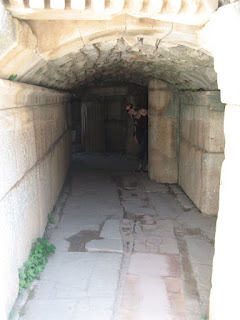We decided it would be worthwhile to pay and go on one of the ship’s shore excursions for our visit to Ephesus. Our ship ported in Kusadsi, Turkey where we were greeted by a group of Turkish dancers.
The tour guide was a knowledgeable and funny guy who looked like Ben Stiller with a crazy fu manchu mustache. He gave us background information on the city and surrounding areas as rode on a charter bus to Ephesus. I’ll take you through the major points of interest that we saw during our tour of Epehsus. I had to look up this information online after our trip because I couldn’t begin to remember all of the details that our tour guide shared.
The main walkway is made of marble and referred to as the Sacred Way or Marble Way. Each day a large number of tourists visit and walk the streets of Ephesus.
One of the first sights that we encountered is Odeion, a small theatre that holds 1400 spectators. It was built around 150 AD and used as a council chamber.
These columns were a part of the Prytaneion, originally built about 3rd century BC, which functioned similar to our present day town halls.
This triangle shaped piece is a carving of Winged Nike, Goddess of Victory.
There are only a few columns left of the Temple of Domitian, which was dedicated to the Emperor Domitian.
The Gate of Heracles is located at the beginning of Curetes Street.
Curetes Street, a mosaic pattern, stretches from the Gate of Heracles to Celsus Library.
The reconstruction of the Trajan Fountain is a smaller scale of the original. The fountain was built around 102 AD and contained an enormous statue of Trajan, of which only the feet and globe remain.
The Temple of Hadrian has a carving of Medusa over the second doorway. In front of the columns are statues of the four emperors who shared the throne of the Roman Empire between 293-305.
Celsus Library is the most famous sight in Ephesus. The construction is assumed to have been completed in 117 AD.
The two story marble building has statues in niches between the doors.
The statues represent wisdom, knowledge, intelligence, and virtue.
Our tour guide told us that there was once an underground tunnel from the library to the brothel across the street, so if the men seemed to be visiting the library quite often, this may not have exactly been the case!
Theatres were built to hold approximately 10% of the town’s population. Ephesus Theatre originally held 24,000 spectators.
There were tunnels that led under the seating near the stage to bring in the gladiators who fought there.
Theatre students from a local college put on a short reenactment of dancing, gladiator fighting, and the famous Cleopatra and Mark Antony who at one time walked the streets of Ephesus.
Our tour guide pointed out a symbol that you see carved in the streets all over the city. It resembles a pizza, but is actually a symbol representing Christianity. If you take the Greek letters IXΘΥΣ, which stand for Jesus Christ, God’s son, Savior, and write them on top of each other they produces this symbol.
From our bus window we could see the prison at the top of a small mountain where the Apostle Paul is said to have been held.

























No comments:
Post a Comment